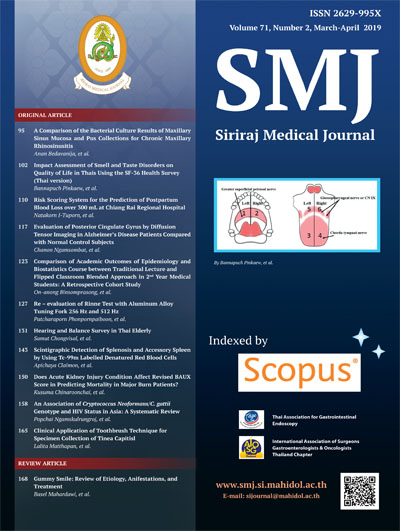The Evaluation of Posterior Cingulate Gyrus by Diffusion Tensor Imaging in Alzheimer’s Disease Patients Compared with Normal Control Subjects
DOI:
https://doi.org/10.33192/Smj.2019.18Keywords:
Diffusion tensor imaging; Posterior cingulate gyrus; Alzheimer’s diseaseAbstract
Objective: Posterior cingulate gyrus atrophy is found in early clinical stage of Alzheimer’s disease (AD) patients.1
Diffusion tensor imaging (DTI) can be used for evaluating microstructure change in brain parenchyma.2 Our
objective was to compare the microstructural change at posterior cingulate gyrus between AD patients and normal
control subjects by using DTI.
Methods: The retrospective review of 23 AD patients, diagnosed by NINCDS-ADRDA with available MRI data
including DTI, and 19 normal control subjects was performed. The DTI parameters of posterior cingulate gyrus of
each group were analyzed and compared.
Results: The mean diffusivity (MD), axial diffusivity and radial diffusivity (RD) of posterior cingulate gyrus were
significantly increased in AD patients compared with normal control subjects (p value <0.001, <0.001, <0.001,
respectively). The fractional anisotropy (FA) was slightly decreased in AD patients compared with normal control
subjects but did not reach statistical significance (p value=0.71).
Conclusion: Microstructural change at posterior cingulate gyrus demonstrated by DTI parameters including MD,
axial diffusivity and RD were significantly different between AD patients and normal control subjects. These results
were probably helpful for early diagnosis, evaluation, and follow up of the AD patients as correlate with clinical
findings.
Downloads
Published
How to Cite
Issue
Section
License
Authors who publish with this journal agree to the following conditions:
Copyright Transfer
In submitting a manuscript, the authors acknowledge that the work will become the copyrighted property of Siriraj Medical Journal upon publication.
License
Articles are licensed under a Creative Commons Attribution-NonCommercial-NoDerivatives 4.0 International License (CC BY-NC-ND 4.0). This license allows for the sharing of the work for non-commercial purposes with proper attribution to the authors and the journal. However, it does not permit modifications or the creation of derivative works.
Sharing and Access
Authors are encouraged to share their article on their personal or institutional websites and through other non-commercial platforms. Doing so can increase readership and citations.















